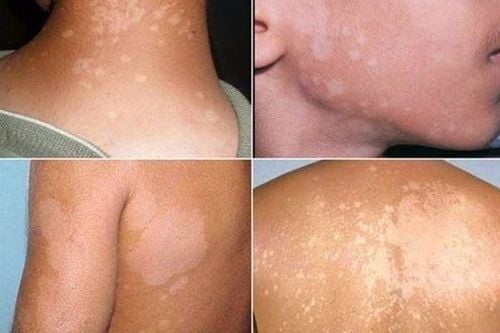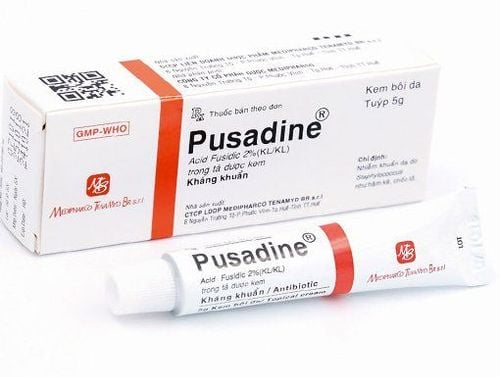This is an automatically translated article.
Purulent sweat gland inflammation is a disease that appears after puberty and can persist for many years, worsening over time, seriously affecting the daily life of the patient.
1. What is purulent sweat gland inflammation?
Inflammation of the purulent sweat glands is a disease that produces small, painful swellings under the skin. The tumor may form a deep lesion under the skin and fester or rupture. It mainly affects areas where the skin is in contact with each other, such as the armpits, groin, buttocks and chest.
Inflammation of the sweat glands usually appears after puberty and can persist for many years, getting worse over time, thereby seriously affecting the daily life of the patient.
Inflammation of the sweat glands can occur in one or more areas of the body. Signs and symptoms of the disease include:
Appearance of blackheads: On the patient's skin will appear small pitted areas, with blackheads inside. Painful, pea-sized tumors: Usually, the patient's body will have a small, painful tumor that lies under the skin for several weeks, even months. After that, many other tumors appear around, in the areas where the hair follicles secrete a lot of sweat and oil. When skin rubs together, tumors can also develop. Deep under the skin causing pus draining: If the tumors are close together, it can form a deep lesion underneath the skin. This wound often takes a long time to heal, and may discharge pus and a foul odor. Some patients experience only mild symptoms. However, if the patient has conditions such as being overweight, stressed, or living in a hot, humid climate, it will make the symptoms of pyelonephritis worse.
2. Causes of purulent sweat gland inflammation
As a chronic inflammatory condition, most people with purulent sweat gland inflammation often have a history of skin infections such as boils, pustules, sebaceous cysts.... In addition, the disease often progresses in In the hot season, people who practice and work hard without taking care of their body will have a high risk of purulent sweat gland inflammation.
About the cause of the disease, experts say that when the oil glands and hair follicles develop but are blocked by fluid or dead skin cells, they are trapped and pushed into the surrounding tissues, helping the bacteria to grow. Bacteria can easily enter and cause infection. The bacteria that invade and cause disease are mainly staphylococcus aureus, streptococcus, E.coli, Proteus.
Besides, a number of factors such as hormones, overweight and obesity, genetics, smoking... can also be the cause of the inflammation of the purulent sweat glands in the patient.
Inflammation of the purulent sweat glands, if not treated properly and promptly, can greatly affect the patient's life, specifically:
Unsightly, long-lasting damage and can leave large scars or sunken skin, hyperpigmentation. In case the lesions appear in the armpits, thighs, it will make it difficult for the patient to live because of the pain. When bacteria enter the damaged skin areas, they will spread rapidly, leading to disseminated infection, lymphedema, scarring of the lymphatic vessels, urethral and rectal fistula, anemia due to infection...

Viêm tuyến mồ hôi mủ thường xuất hiện sau lứa tuổi dậy thì và có thể tồn tại trong nhiều năm
3. Treatment of purulent sweat glands
To help control and prevent dangerous complications, treatment of purulent sweat glands is necessary. Currently, the treatment methods for purulent sweat glands can be medication, surgery or both.
3.1 Use of drugs to treat purulent sweat glands For the treatment of purulent sweat glands by medicine, the doctor may prescribe one or more drugs for the patient to use. These medications include:
Antibiotic creams: Your doctor will prescribe antibiotic skin creams to prevent infection in mild cases of purulent pyelonephritis. Topical creams contain antibiotics such as clindamycin and gentamicin. Oral drugs with systemic effects: Oral antibiotics such as clindamycin, rifampin or doxycycline will also be effective in treating purulent sweat glands for patients. Pain relievers: If the lumps are causing too much pain, your doctor will prescribe pain relievers. If over-the-counter pain relievers don't work, your doctor may prescribe stronger medications. 3.2 Surgical treatment of pyelonephritis Surgery to treat pyelonephritis may include 1 of the following:
Removal of deep lesions: People with inflamed sweat glands in the Both moderate and severe levels must use this method. The goal is to help remove the tissue on the surface of the skin to reveal the damage inside and treat more thoroughly. Surgery to remove the tumor: This is often indicated to remove an inflamed tumor. Tissue excision with electric knife: This technique will be applied by doctors to patients with severe purulent purulent gland inflammation. Surgical excision: If the patient has persistent or more severe symptoms, the affected skin will be removed, then another patch of skin will be applied to the wound. In addition to choosing the most suitable treatment method, people with purulent sweat gland inflammation should note a few things as follows:
Must lose weight in case of excess body weight; Quit smoking as well as alcohol; Use cleaning and disinfecting solutions on the skin every day to avoid infection; Apply a warm towel at the site of the tumor to let the pus drain out. At the same time, wear loose and comfortable clothes because wearing tight clothes will cause the tumors to rub against the fabric, from which the disease will be more serious; Avoid using perfumes or deodorants on damaged skin. Although purulent gland inflammation can persist for years, if diagnosed and treated early, symptoms of disease will improve positively. Therefore, if you suspect that you are suffering from this disease, you should go directly to a reputable hospital for a timely examination by a specialist. Currently, Vinmec International General Hospital is one of the leading prestigious hospitals in the country, trusted by a large number of patients for medical examination and treatment. Not only the physical system, modern equipment: 6 ultrasound rooms, 4 DR X-ray rooms (1 full-axis machine, 1 light machine, 1 general machine and 1 mammography machine) , 2 DR portable X-ray machines, 2 multi-row CT scanner rooms (1 128 rows and 1 16 arrays), 2 Magnetic resonance imaging rooms (1 3 Tesla and 1 1.5 Tesla), 1 room for 2 levels of interventional angiography and 1 room to measure bone mineral density.... Vinmec is also the place to gather a team of experienced doctors and nurses who will greatly assist in diagnosis and detection. early signs of abnormality in the patient's body. In particular, with a space designed according to 5-star hotel standards, Vinmec ensures to bring the patient the most comfort, friendliness and peace of mind.
Please dial HOTLINE for more information or register for an appointment HERE. Download MyVinmec app to make appointments faster and to manage your bookings easily.













